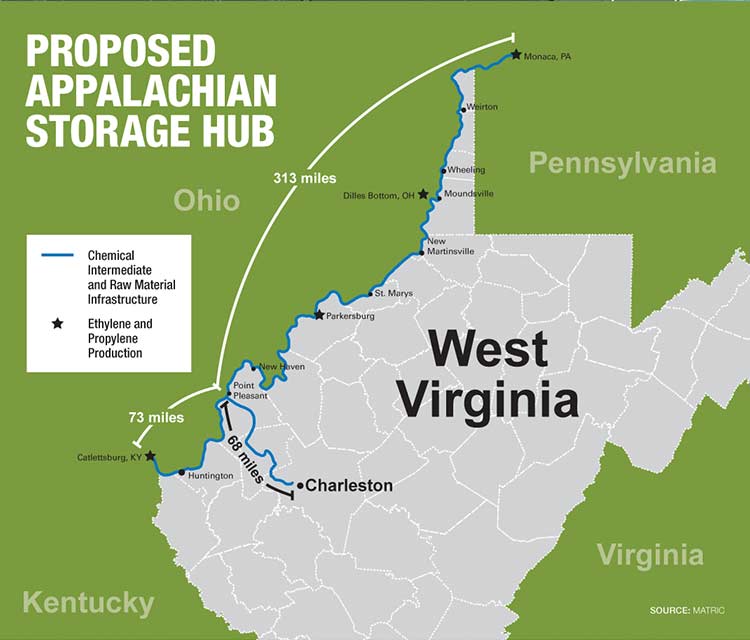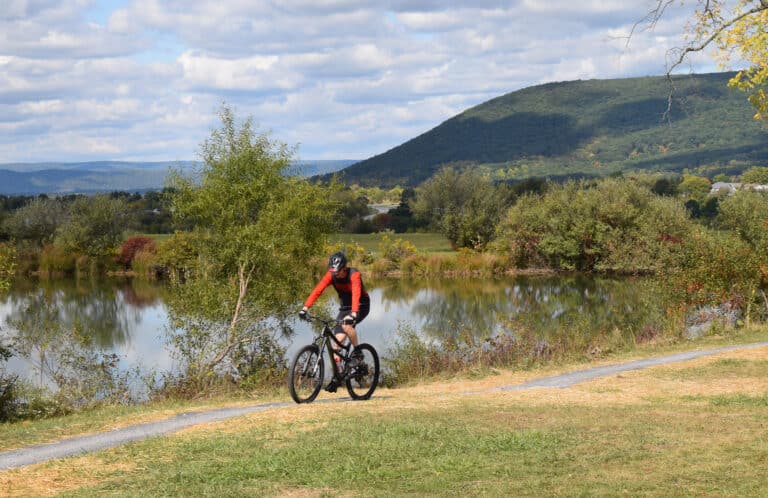A development corporation is seeking a $1.9 billion U.S. federal loan guarantee to help build an Appalachian storage hub for natural gas liquids that already has significant funding from Chinese investors.
China and the U.S. are planning a massive petrochemical hub in West Virginia.
The biggest energy project you’ve never heard of commonly goes by the acronym ASTH—the Appalachian Storage and Trading Hub. This massive petrochemical hub in West Virginia and Pennsylvania would be the largest infrastructure in the region’s history, consisting of hundreds of miles of pipelines, fracked gas processing facilities, and underground storage of petrochemicals and fracked gas liquids.
Once completed, ASTH would stretch along the Ohio-West Virginia border from Pennsylvania to Kentucky along the Ohio River. Its powerful backers—including the Trump administration, the Chinese government, and Shell Oil—claim it will revitalize a region torn apart by a fizzling coal industry. President Trump and Xi Jinping, the president of China, met this past November on a trade mission, during which Xi Jinping signed on to invest nearly $84 billion in the ASTH over the next two decades—that’s more than West Virginia’s entire 2016 GDP.
U.S. Representative David McKinley (R-W.Va.) says that the petrochemical hub “fits in well with Trump’s desire for more federal infrastructure investment.” Opponents say it will be the country’s next Cancer Alley.
“‘Appalachian Storage and Trading Hub’ is a benign name for how massive and detrimental this project and its impacts would be,” says Dustin White. His roots in West Virginia stretch back 11 generations. He comes from a long line of hardworking coal miners, and he’d always felt proud of that way of life. That changed, however, when he learned his community cemetery and the entire mountain where he his family had lived were threatened by mountaintop removal mining.
This discovery spurred him to look more closely at the coal industry and its impacts on Appalachians. The legacy of exploitation he found challenged many of his beliefs. “It slapped me in the face,” says White. “I don’t want others to go through that.”
White believes that the petrochemical hub will lock Appalachia into another century of exploitation by the fossil fuel industry. “Coal dug Appalachians’ grave, oil-and-gas built the coffin, and petrochemical industry wants to put the nails in the lid.”
The petrochemical hub has long graduated from early planning stages. “They’ve been working on this for ten years with support from both the West Virginia and Ohio governments,” says Cheryl Johncox, Sierra Club organizer. “Despite this, it hasn’t been on the radar for most citizens or even many large environmental organizations.”
John Morgan, a resident of Belmont County, Ohio, since 1979, became aware of ASTH eight years ago when gas companies started leasing land adjacent to his community. He has seen firsthand the impact of extractive industries and how the explosive rise of shale gas has irreparably changed the region. His neighbors are especially weary since multiple homes were damaged years ago by nearby mining operations in unstable geology.
“Most people have no clue how much more damage is coming if it doesn’t stop,” Morgan says. At a meeting, a gas company representative divulged that around 6,000 shale wells would be required to extract the desired natural gas in Belmont County alone. “The industry doesn’t want people to know about this,” he says.
Advocates of the ASTH say it’s needed to meet increasing energy demands and reduce America’s dependence on fossil fuel imports. They say that it will be safe, create long-term jobs, lower locals’ natural gas rates, and ultimately boost a struggling Appalachian economy.

However, if built, the ASTH will export much of the fracked gas overseas to China. If the majority of the product will be leaving our shores, local taxpayers may be footing the bill without experiencing lower energy rates or even receiving the gas that’s fracked from beneath them.
Even worse, says Johncox, this petrochemical hub locks the region into fossil fuel dependence for decades, when really we need to be investing in a renewable energy infrastructure.
Most of the ASTH will be built along the Ohio River, which the EPA has identified as the most polluted body of water in the country for the last seven years. The Ohio River also provides drinking water for millions of people in the region.
In 2015, Princeton University researchers found that infants born within one kilometer of a fracking well were 25 percent more likely to have low birth weights than infants born more than three kilometers away. And many of the toxins used for drilling and processing petrochemicals are known carcinogens.
Leaks, spills, and explosions are also industry-admitted risks. Appalachia’s Cancer Alley could be even more dangerous than the Gulf Coast’s because of its mountainous topography. Air pollution in the mountains gets trapped in low valleys like a smothering blanket, and any leaked gases from underground storage could remain stagnant and ignite with one spark.
“It’s horrible what’s going on in Texas and Louisiana, but they have Gulf breezes moving air out of the region. We don’t have that, and it’s a worse-case scenario,” says Johncox.
White says that the gas Industry frequently “targets those they believe can’t put up a resistance because they’re busy surviving or are seeking a quick fix for the economy.” Already, there are thousands of abandoned fracking wells across Appalachia leaking natural gas, oil, and acid mine drainage into the groundwater, surface water, and air. Locals pay the price—and so will coming generations, says White.
And what about jobs? Plant operations, which are heavily automated, will create an estimated 350 to 1,200 permanent jobs. For pipelines, the number of permanent jobs will likely be even smaller. The Brookings Institution found that the Dakota Access Pipeline will provide only 40 full-time post-construction positions.
Meanwhile, the renewable energy industry already provides five times more jobs than coal, oil, and natural gas combined in the United States.
West Virginia’s thriving outdoor recreation and tourism industries could also suffer from the proposed petrochemical hub. West Virginia is home to some of the most spectacular whitewater, mountain biking, climbing, and hiking in the nation. According to the Outdoor Industry Association, the outdoor sector generates 91,000 direct jobs in West Virginia, and 215,000 in Ohio, and more than a quarter million in Pennsylvania, dwarfing the number of jobs from coal, oil, and gas combined in Appalachia. The outdoor economy also creates over $62 billion in outdoor-related consumer spending in West Virginia, Ohio, and Pennsylvania.
White believes there are wiser choices for the future of this beautiful region, choices which preserve its natural resources and prioritize the health of all over the profits for a few. “It took me losing friends and family and family history to an extractive industry,” says White. “Folks need to wake up and realize what’s coming and not wait until it hits their backyard.”








